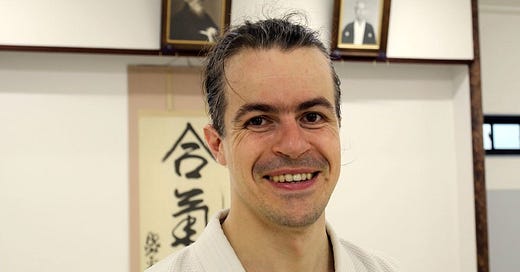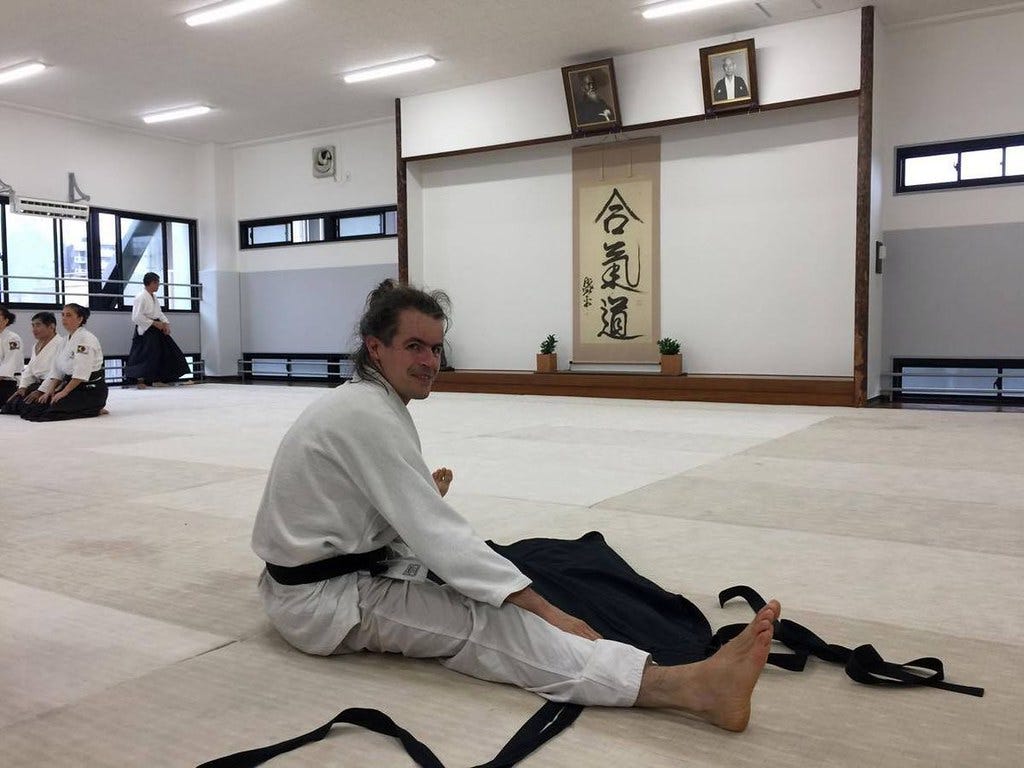I’m in Japan now, enjoying Tokio and the countryside, not writing much. So I decided to share an article that I wrote in 2016 in Czech language after my second visit to the Aikikai Hombu Dojo. I’m curious how my current stay in Tokyo will update my view.
Here goes the old text:
In Tokyo, there’s an Aikido dojo that the founder of Aikido, Morihei Ueshiba, opened back in 1931. Since then, the place has seen a lot of development - of Aikido, of Osensei’s students as well as of Japanese society.
Today, his grandson Moriteru Ueshiba, his great-grandson Mitsuteru Ueshiba, and many other teachers—some among the highest-ranking in the world—teach there. And the spirit of the founder still lingers in the air.
About a year ago (in 2015), I wrote about my first week of training at Aikido Hombu Dojo. Now, after a few more interesting training days, some things have become a little clearer for me—and I'd like to share the experience.
A Special Training Place
I’ve trained in many clubs and schools across different countries, but Hombu Dojo is truly a special place.
It’s probably the only place in the world where, in a single day, I can train with a Brazilian, a Russian, a Greek woman, a German, and a Japanese partner.
Where I can work with a teenager who's seventeen and, right after, with an elderly gentleman over seventy—someone who actually studied Aikido under the founder himself.
It’s a place where many people practice with deep dedication. And one of the few places where people from different schools, approaches, and ideas about training meet—and share experience through direct physical contact.
Of course, training there is intense. The rules are strict, and if I unintentionally break any, the correction can be quite blunt.
Of course, there’s not much technical explanation—if you don’t watch carefully (and quickly), you might not even know which technique is being practiced. Honestly, if I needed to learn basic techniques from scratch, regular classes at Hombu would probably be really tough for me.
If I went there to show off how good I am, I'd quickly be humbled—there are people who are “more skillful”, and/or “stronger”. The mat is crowded, and training demands much more focus than what we're used to. And if I wasn’t in decent physical shape—or if I didn’t want to fall and get back up all the time—after half an hour, my thighs would hurt so much I'd probably skip the next class.
I hear these things a lot when people talk about Hombu.
But honestly?
I’m starting to really enjoy it there.
The Intensity is a Good Challenge
It challenges my attention, my physical and mental endurance. It shows me clearly what I’m still struggling with—technically and emotionally. Because of the intensity, feedback is immediate. It's up to me how I deal with it.
Maybe it's also because I never stay longer than a week—but the intensity and variety are incredibly inspiring. In just one hour, I get as many training impulses as I would in a month back home. And it gives me a glimpse into the environment most of our teachers—and certainly all of their teachers—grew up in.
Of course, I know many people who come to Hombu once, take a photo with a teacher, and never return. And sure, you can see one thing in many different ways—positively or negatively.
My friend Misha, a teacher from a different country than the Czech Republic, summed up these philosophical thoughts with simple, straightforward humor. After his first day of training at Hombu, he said something like:
"Now I understand why the older teachers in our country didn’t want us to come to Hombu. Because they didn’t want us to see those eighty-year-old grandpas falling and getting back up for a whole hour. Meanwhile, our ‘older’ teachers back home are in their mid-forties, holding fifth dan, and leave the mat after the first technique at seminars because they say they’ve fallen enough in their lives."
He might be onto something.
For example, on Wednesday’s regular class, among sixty people on the tatami, there was an almost eighty-year-old lady, a well-known sixty-year-old Japanese teacher, and an eighth dan master.
Roughly a quarter of the practitioners were seniors. And they were all falling, getting up, training just like everyone else.
Outside, it was monsoon season—hot and humid enough to make you want to faint.
Inside, we were all swimming in the sound of falls and our own sweat.
That intensity and shared work create a unique and powerful atmosphere—one that’s incredibly precious to me. It’s one of the reasons I’ll be happy to return to Tokyo. And it’s why I’ll keep recommending the experience to other Aikido practitioners.
If you ever find yourself in Tokyo, try to join a few classes at Shinjuku.
You might see—and feel—things you won’t easily find anywhere else.
After my return from Japan this year, I may write about my fresh experience.
And what about you? Have you already visited Aikikai Hombu Dojo? How was it for you?
PS: Just recently I’ve found the article Is the Aikikai Hombu Dojo Still Relevant and Should You Go? by Guillaume Erard on the same subject, but much more detailed and profound. If you’re interested in visiting Tokyo and practicing there, you can read it too.






Thanks for your post. I have not trained at Hombu dojo only in Iwama with Saito Sensei in 1988 so I appreciate your insight into training at the headquarters. Now at 70 after 39 years on the mat I still take a lot of falls most days though I must say some days it is harder to get up and after a couple of hours at a seminar or multiple classes every joint aches but it is still a pleasure to train especially once I get moving a bit. I will say I do have to respect my age and all the years of wear and tear on the body. Best wishes enjoy your time there will I am sure remain treasured decades later when you reach a ripe old age. JM
To be honest, I was in Tokyo in 2016, but I didn´t find the courage to go to Hombu dojo and train there. I was alone, and I didn´t know Hombu dojo worked. After reading your article, I kind of regret it. Well, maybe I´ll have another chance in the future :-)